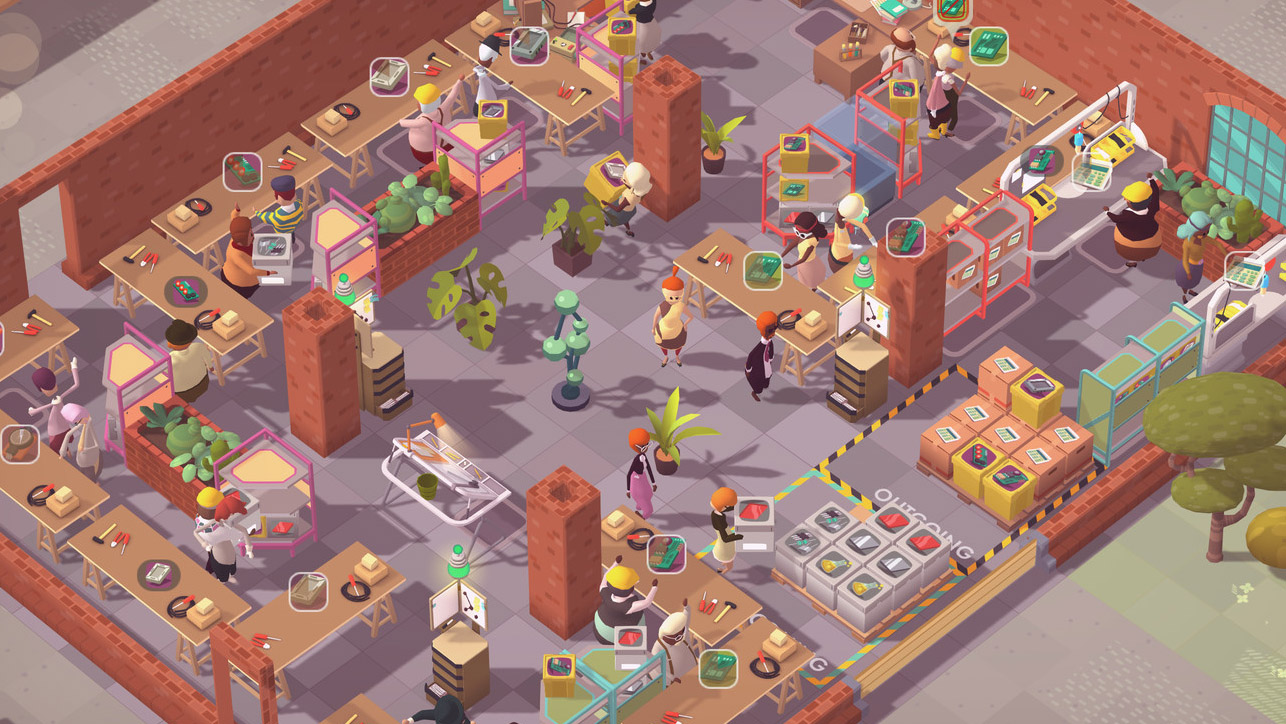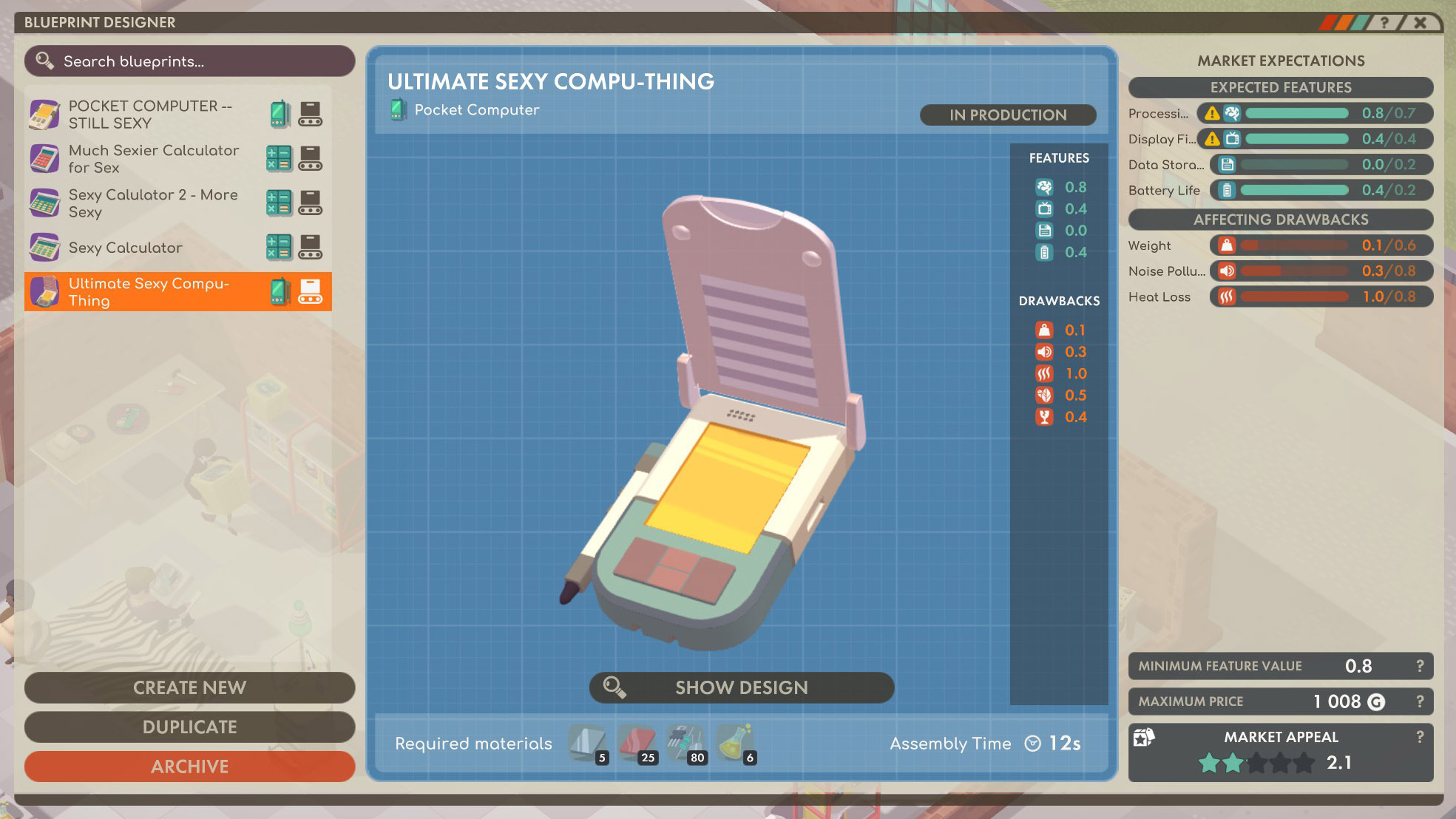There's some Factorio DNA in this tycoon game about running a calculator factory
Set up production lines and design new products to keep up with the tech market in Early Access sim Good Company.

Good Company, a factory tycoon game now in Steam Early Access, is giving me some heavy Factorio vibes. Calm down: I'm not saying it's the next Factorio. But there is a bit of shared DNA there. You set up an assembly line of workers and workstations and turn parts into pieces and pieces into products, and as the products get more advanced the production chain needs to expand and run efficiently or it'll just wind up a big confusing awful mess that makes you want to burn your factory to the ground in shame and start over.
That's what happens when I play Factorio, at least, and that's what happened when I played Good Company. The goal is to advance from producing and selling simple calculators to more complex electronic devices, and eventually start building robots.
I did not eventually start building robots. I barely even made it to pocket computers.
The furthest I got, technology-wise, was the invention of a flip phone. And I'm not gonna lie, I was pretty damn excited to invent a flip phone. Yes, I ran my company into the ground to do it, but it was worth it. Just look at that beauty:

Things started simply enough. I had a warehouse and I wanted to begin manufacturing calculators. I ordered supplies: Chemicals for the battery, plastic for the case, electronics for the display and circuits. I set up little workstations for each component to be turned into the modules I needed, hired workers and assigned them to the stations, and dragged little lines to lead each component through the factory.
A line goes from the chemical sitting at the delivery zone to a shelf, and then from the shelf to the battery workstation. The completed battery goes to another shelf, then to the assembly bench, where it's put together along with the calculator case, LED, and circuits, and then finally to the outgoing shipments zone, where it's whisked to market. I named my calculator Sexy Calculator, and it was sexy. Sexy as hell. I designed it with two batteries for longer life, and it sold pretty darn well.
For a while.
The biggest gaming news, reviews and hardware deals
Keep up to date with the most important stories and the best deals, as picked by the PC Gamer team.
Like in Factorio you have a physical body in Good Company—you're not just clicking things from heaven. This is good and bad. You can perform tasks in the factory yourself, which is handy if, say, a shelf is so filled with components that no one can put anything else on it, or if you're having a budget crisis and don't want to hire a new worker for a while. It's bad because you can't just move the camera around to observe your factory empire—if you want to see what's going on in another building, like maybe why no one has brought over a box of batteries the assembler is patiently waiting for, you've gotta physically walk there. I spent a lot of time waddling around trying to oversee the assembly line and make sure nothing was going wrong. (A lot was going wrong.)
The real issue was when I wanted to advance my Sexy Calculator from a basic adding machine to something a bit more flashy, which I had to do. There's a market for tech products, and it was slowly advancing to new phases while I was busy churning out my basic (but sexy!) calculators. Soon customers weren't satisfied with the battery life and screen fidelity of my Tier 1 Sexy Calculator. They wanted more.
As I researched and unlocked new tech tiers, that simple battery I was making from just chemicals was replaced by a battery stack that also required metal and plastic. The LED array made from electronic parts became an LED Matrix which required the original array plus a circuit board and more electronic parts.
The smoothly running little production line I set up for my Sexy Calculator was in no way set up to handle Sexy Calculator 2. The whole factory needed to be restructured just to make a marginally more attractive calculator.
Which is when things began falling apart. I plopped in new workstations and hired new workers, but dragging all those little production lines around quickly got confusing. I'd waddle back and forth checking the recipes for new components, then quickly forget what I'd been trying to untangle a minute ago. I briefly got fed up, fired everyone, deleted every single shelf and station and restructured the entire factory from scratch, which got me back on track for Sexy Calculator 2. But I'd lost a lot of time, and the market continued to develop. I needed to design Sexy Calculator 3 almost as soon as Sexy Calculator 2 was hitting the store shelves.
And soon after, the market decided my calculators, sexy or not, were entirely 10 minutes ago and we were all moving on to pocket computers. Research led to new tiers, new tiers needed new workstations, new employees, and a network of new production lines. It felt impossible to keep up, and except for the few brief moments when I got a product to market before customers wanted some new hotness, I was constantly operating at a loss. I did get my flip phone (named Ultimate Sexy Compu-Thing) to market, but it was already outdated. Even firing everyone and selling off the components couldn't save me from bankruptcy.
The current lack of a real management layer wasn't helping me stay afloat either. Good Company's Early Access roadmap has me hopeful, though. It includes things like marketing, employee abilities and qualifications, conveyor belts, and more logistic options which will hopefully let players make some adjustments when they're running in the red. (Please add bank loans.)
I'll probably wait to see how Good Company develops further before I try it again, but I really would like to give it another go. It's got a lovely art style, it's satisfying when a production line (briefly) is running smoothly, and I really enjoyed designing my various sexy calculators, pocket computers, and flip phones.

Chris started playing PC games in the 1980s, started writing about them in the early 2000s, and (finally) started getting paid to write about them in the late 2000s. Following a few years as a regular freelancer, PC Gamer hired him in 2014, probably so he'd stop emailing them asking for more work. Chris has a love-hate relationship with survival games and an unhealthy fascination with the inner lives of NPCs. He's also a fan of offbeat simulation games, mods, and ignoring storylines in RPGs so he can make up his own.

